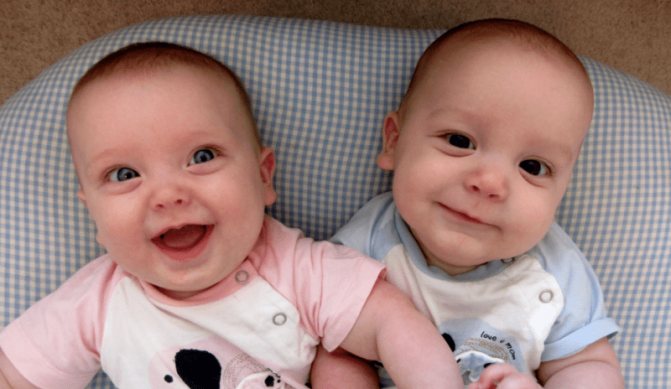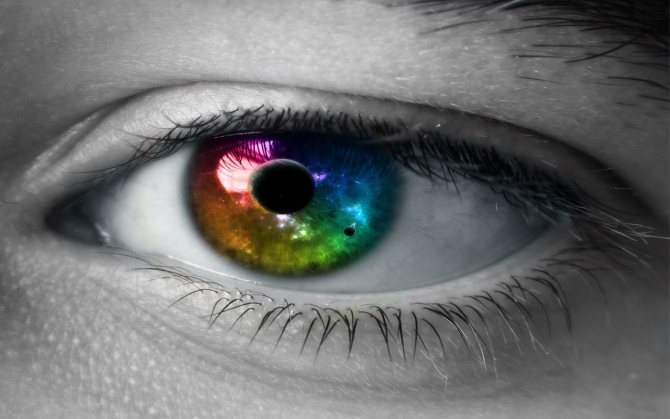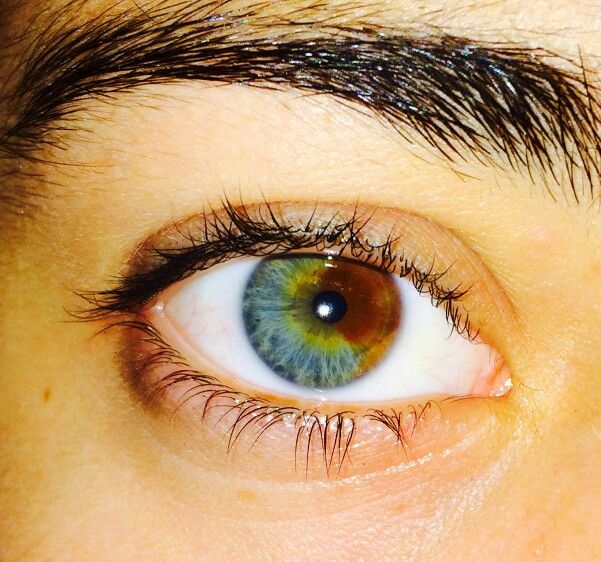Genetic characteristics of eye color
The color of a child’s eyes is one of the inherited characteristics that makes him similar to his father, mother or close relatives, which are grandparents.
In the laws of genetics, there are two concepts - dominance and recessivity. The dominant trait is always stronger; in a child it suppresses the weaker one - the recessive one, but does not block it completely, allowing it to manifest itself in the next generation.
Brown eye color always prevails over green, green over gray and blue. However, if the baby has a blue-eyed grandfather or a gray-eyed grandmother, then the eyes may be blue or gray. This means that the trait is passed on through generations.
It must be remembered that the laws of heredity are much more complex than those that we study at school.
Thus, scientists have found that sections of six genes affect the color of a child’s iris, so there are thousands of variations of just shades of the same eye color. In addition to the classical rules of genetics, there are mutations, an example of which is purple eye color.
Some interesting facts about eye color
Only two percent of the world's population has a green iris.
The color of a child’s eyes depends not only on genetics, but also on place of residence and nationality.
Among Russians, the most common eye colors are gray and blue; only thirty percent of the population have brown eyes. In Ukraine and Belarus, fifty percent of the population has brown irises, and in Spain and Brazil as many as eighty.
Heterochromia is considered a rare genetic mutation in children. These little ones have different eye shades.
Albinism in infants is the absence of pigment that gives the iris a certain color. These babies' eyes will be red.
It is impossible to determine the color of the iris of both an unborn baby and a toddler up to one year old with one hundred percent accuracy.
Jaundice can affect the color of a child's iris. With this disease, yellowing of the whites is observed, so it is impossible to accurately determine the eye color of a sick child.
Anatomical and physiological features
What determines the color of a child’s eyes? It is determined by the amount of melanin. This is a special pigment contained in the iris of the eye. There are more pigment cells in the posterior layer of the iris (with the exception of albinos) than in the anterior one.
This allows light rays not to be scattered, but to be absorbed, due to which complex processes of visual image formation occur and the visual process is carried out.
Pigment cells begin to synthesize melanin only under the influence of light. Depending on how much melanin is contained in the structure of the anterior layer of the iris, the following eye colors are distinguished: blue, cyan, gray, green, olive, brown, dark (black).
But there are a large number of their shades and tones. There are even scales for classifying iris color. The most famous are the Bunak scale and the Martin-Schultz system.
A few words should also be said about the characteristics of the shades:
- Gray eyes and eyes of all shades of blue and cyan contain virtually no pigment. The light color of the vessels of the iris, combined with the scattering of light in its tissues, gives such a shade. The high density of collagen fibers in the structure of the anterior layer of the iris determines the lighter color;
- The green tint of the eyes appears due to the fact that the amount of melanin in them is higher than in gray and blue ones. In addition, the presence of lipofuscin pigment plays a large role in creating this color;
- Brown-eyed and dark-eyed people have the highest melanin content, which allows them to absorb almost all of the incident light.
Reasons for different eye colors in children
Sometimes parents may notice that the baby's irises have a slightly different shade. In this case, we can talk about heterochromia. This phenomenon occurs quite often. One eye is blue and the other is brown. Heterochromia is caused by the fact that one of the irises around the black pupil produces less melanin compared to the other.
Heterochromia is divided into several types:
- Full. The color is fundamentally different.
- Sectoral. One eye has two colors distributed in different proportions across the iris.
- Central. The iris is divided into several rings, each of which has its own color.
If a child has different eyes, this indicates both genetic characteristics and an acquired characteristic. Heterochromia may indicate some diseases, but in most cases it is not caused by pathologies. There have simply been mutations in the genes that are responsible for the amount of melanin in the eye.
Important! Different eye colors can be passed on to offspring provided that the DNA has changed at conception.
If heterochromia is acquired, it can occur due to injury, problems with innervation or inflammation.
Thus, if the baby was born with a different eye color, you should not worry and suspect your soulmate of cheating. It happens. Moreover, a person’s eyes can change even in adulthood. There are known cases when children's irises were gray, and then shifted slightly in color towards green.
For what reason does the eye color change in infants?
What eye color are babies born with? The current opinion is that almost everyone is born with blue eyes. This is not entirely true. Newborns' eyes can be either sky blue or dark gray.

Even twins can have different shades. The initial color depends on the number of pigment cells. They begin to function immediately after birth, after the first rays of light enter the eye.
Eye color options
Blood type of a child from his parents - table
There are many options for coloring the iris. Tones can be either pure, they are called basic, or mixed. It all depends on the genetic information that the newborn received from his ancestors.

Child with gray eyes
Basic
The main shades are considered to be:
- brown;
- series;
- blue;
- green.
These colors are obtained by people whose collagen fibers are located evenly, densely, close to each other. Then the determining factor remains the inherited amount of melanin, which stains the cornea and does not allow it to show through.
The brown color is determined by the high content of collagen, which prevents light rays from penetrating the stroma. The light absorbed by such a cornea is reflected and gives a deep brown tint. Statistical studies claim that this is the most common color option for the iris.
Shades
Genetic information, which should be inherited, can be combined in such a way that the child who gives birth will not have a pure eye color, but a mixture of several shades. Not everything depends on the genes that the body's cells carry.
Depending on the transparency of the stroma, colors can change, acquiring intermediate shades:
- amber;
- grey-green;
- gray-blue;
- black;
- light brown.

Changing color – chameleon
Additional Information. There is a small percentage of people who have chameleon eyes. The factor influencing the color is the degree of illumination of the space in which the owner of such a rare feature is located.
Heterochromia
Not all people have both eyes the same color. There are also those whose pupils differ significantly in color. This is not just dark brown and brown, but a combination where the left eye, for example, is blue, and the right eye is brown. Such a difference in color is not all that nature can do - there are also people whose segment of one pupil differs in color from the rest. It looks like a filled circle, one sector of which someone repainted in a different color.

Segmental heterochromia
Heterochromia is a dominant feature. This means that a parent with such a feature of iris coloring will also have children of different iris colors. It is only with a small degree of probability that a couple in which one of the partners has heterochromia will have a child without this feature.
Who influences a child's eye color?
There are cases when brown-eyed parents give birth to a blue-eyed child. This exception is quite rare, occurring in only 6.25% of children. Why does this happen?
Each person copies two versions of the same gene: from the father and from the mother.
These two versions of the same gene are called alleles. In each pair, some alleles are dominant over others.
In general, brown eye color is dominant (predominant, overwhelming), and most often the lighter one (recessive allele) does not appear in the presence of the dominant one. A recessive allele can appear if it is paired with the same recessive allele.
However, not only parents, but also grandparents can contribute to modeling the child’s appearance. So, if one of the parents still has a hidden recessive allele, then he may well pass it on to the child. Consequently, brown-eyed parents may give birth to a blue-eyed baby, inheriting this trait through a generation. But the opposite situation is unacceptable: a blue-eyed father and mother cannot give birth to a child with brown eyes.
In general, genetics is a complex thing, sometimes it drives us into a dead end. Therefore, you should listen to your heart and trust your loved one, then all sorts of nonsense will not enter your head. After all, it is much more important: whether the child is healthy, and not what color his eyes are!
Will her daughter get her father's rare hair? To get answers to these questions, you can go to the soothsayer Baba Inga or peer into the coffee grounds. However, instead of engaging in shamanism, it’s better to remember your school biology course.
While you exchanged notes with your best friend or counted crows while looking out the window, the teacher patiently explained to you and your classmates what happens when the female and male reproductive cells unite. In the process of merging, a new life is born, which receives part of the paternal and maternal genes, which carry a huge amount of information: they are responsible for the appearance, health, and mental abilities of the unborn child. Despite the fact that the baby receives all the signs from his mother and father, he is born as a completely unique personality, whose exact portrait cannot be drawn by any scientist in the world: no one knows for sure exactly how the genes are intertwined in a bizarre way. However, there are a number of features that can be predicted with a certain degree of probability: for example, what the child’s eye color, hair shade, height, etc. will be.
Layout of the eye color of the unborn child
In order not to get confused in explaining the genome, an approximate general table was adopted in order to determine the eye color of the unborn child. According to her:
- 2 brown-eyed parents will give birth to a brown-eyed child in 75% of cases, green-eyed in almost 19% of cases, and blue-eyed in only 6% of cases.
- With brown-eyed and green-eyed parents, a child in 50% of cases will have brown eyes, in almost 38% of cases - green, and only in almost 13% - blue.
- A brown-eyed and blue-eyed parent will again have a brown-eyed child in 50% of cases, and a blue-eyed child in the remaining 50% of cases. A green-eyed child cannot be born to such parents in any case.
- Two green-eyed parents will give birth to a child with green eyes in 75% of cases, blue-eyed in 24% of cases, and brown-eyed in only 1% of cases.
- A green-eyed and blue-eyed parent will have equal chances of giving birth to a child with blue or green eyes; they cannot have a brown-eyed baby.
- Two blue-eyed parents will have a blue-eyed child in 99% of cases and a green-eyed child in only 1% of cases. Brown eyes cannot work here either.
Interesting facts include the following cases:
- The majority of the world's population is brown-eyed, and the least number of green-eyed people is observed - only 2% of the total number, and green-eyed female children are most actively born in Turkey and Iceland.
- You can hardly find green-eyed people in Asian, South American and Middle Eastern countries, but blue eye color is very common among Caucasians.
- The formation of eye color is completed only by the age of 4, and all newborns are born with the same blue eye color, only for some it darkens or turns into other shades.
- Brown eyes are blue eyes covered with brown pigment. Modern medicine has reached the point where there is an operation to change eye color from brown to blue, although this will not affect the offspring.
- Some scientists believe that blue eye color is due to a genetic mutation, so all blue-eyed people have one common ancestor.
- Albinos have red eyes due to the lack of iris pigment.
- Black or yellow eyes are actually brown and green, respectively, but the rays falling on them reflect the color differently.
Thus, you can predict the eye color of your unborn child with a high degree of probability. In rare cases, children may be born with different colored irises in both eyes, but this is not a disease, just a unique feature.











